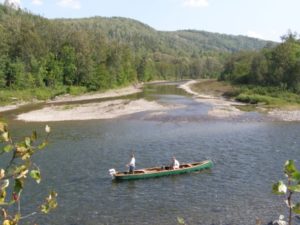Rivers, Wetlands, and Climate Change
The rivers and wetlands of New Brunswick are important in many ways. They provide habitat for many species. They provide us with clean and safe drinking water. They are a source of recreation for many, and a source of inspiration for others. They are also prone to significant impacts as a result of climate change.

What may happen
What may happen with rivers and wetlands?
- Changes in precipitation patterns and temperature will result in significant extremes in groundwater levels. Spring floods will trend towards record high levels over the past, and more flooding in summer and autumn can be expected due to sever storms leading to greater runoff.
- Record low levels will result from increased evaporation from surface waters and less water being retained by the land following hard rains. Extended periods of drought will also lead to a decrease in water levels. The fluctuations in river conditions, and the accompanying increase in water temperatures, will endanger many of our aquatic species, like Atlantic Salmon and brook trout, which rely on specific water conditions to thrive.
- The rapid rise and fall of river levels will contribute to erosion of river banks. Areas currently covered by water will be exposed to heat and air, drying them out, and making them more susceptible to erosion when higher waters return.
- The threat to wetlands and lakes lies largely in evapotranspiration, the loss of water to the air because of heat and dry conditions. Again this will result in lower water levels. Some wetlands may dry up altogether, resulting in loss of habitat to many species and possible extirpations. A side effect to the drying out of peat bogs is that it will increase the amount of carbon released into the atmosphere, thus adding to the problems of climate change.
- Groundwater will face an increased risk of pollution in the future. Less predictable growing conditions may necessitate the use of more pesticides and fertilizers for farming and forestry, and these contaminants will be more likely to enter the water sources when strong storms cause runoff.
